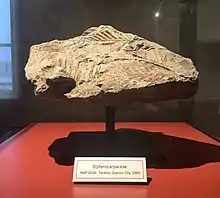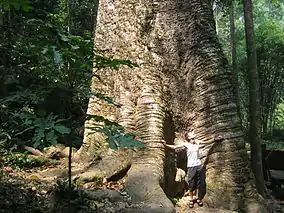Dipterocarpaceae
Dipterocarpaceae is a family of 16 genera and about 695 known species[3] of mainly tropical lowland rainforest trees. Their distribution is pantropical, from northern South America to Africa, the Seychelles, India, Indochina, Indonesia, Malaysia and Philippines.[4][5] The greatest diversity of Dipterocarpaceae occurs in Borneo.[6]
| Dipterocarpaceae Temporal range: | |
|---|---|
 | |
| Dipterocarpus retusus | |
| Scientific classification | |
| Kingdom: | Plantae |
| Clade: | Tracheophytes |
| Clade: | Angiosperms |
| Clade: | Eudicots |
| Clade: | Rosids |
| Order: | Malvales |
| Family: | Dipterocarpaceae Blume (1825)[2] |
| Genera | |
The largest genera are Shorea (196 species), Hopea (104 species), Dipterocarpus (70 species), and Vatica (65 species).[7] Many are large forest-emergent species, typically reaching heights of 40–70 m, some even over 80 m (in the genera Dryobalanops,[7] Hopea[8] and Shorea),[8] with the tallest known living specimen (Shorea faguetiana) 93.0 m tall.[8]
The species of this family are of major importance in the timber trade. Some species are now endangered as a result of overcutting, extensive illegal logging, and habitat conversion. They provide valuable woods, aromatic essential oils, balsam, and resins, and are a source for plywood.
Taxonomy
The family name comes from the type genus Dipterocarpus which is derived from Greek words δι di "two", πτερόν pteron "wing", and καρπός karpós "fruit"; the words combined refer to the two-winged fruit available from trees of that genus, other related genuses with winged fruits of more than two are included in the family as well.[9]
Classification
The dipterocarp family is generally divided into two subfamilies:
| Phylogeny of the Dipterocarpaceae[6] | ||||||||||||||||||||||||||||||||||||||||||||||||||||||||||||||||||
|
- Dipterocarpoideae: the largest of the subfamilies, it contains 13 genera and about 475 species. Distribution includes the Seychelles, Sri Lanka, India, Southeast Asia to New Guinea, and a large distribution in Borneo, where they form the dominant species in the lowland forests. North Borneo (Brunei, Sabah, and Sarawak) is the richest area in the world for dipterocarp species.[7] The Dipterocarpoideae can be divided morphologically into two groups,[6][10] and the tribe names Shoreae and Dipterocarpeae are sometimes used, but genetic evidence so far does not support this division:[11][12]
- Valvate - Dipterocarpeae group (Anisoptera, Cotylelobium, Dipterocarpus, Stemonoporus, Upuna, Vateria, Vateriopsis, Vatica). The genera of this group have valvate sepals in fruit, solitary vessels, scattered resin canals, and basic chromosome number x = 11.
- Imbricate - Shoreae group (Balanocarpus, Hopea, Parashorea, Shorea). The genera of this group have imbricate sepals in fruit, grouped vessels, resin canals in tangential bands, and basic chromosome number x = 7. A recent molecular study suggests that the genus Hopea forms a clade with Shorea sections Anthoshorea and Doona, and should be merged into Shorea.[11]
- Monotoideae: three genera, 30 species. Marquesia is native to Africa. Monotes has 26 species, distributed across Africa and Madagascar. Pseudomonotes is native to the Colombian Amazon.
A recent genetic study found that the Asian dipterocarps share a common ancestor with the Sarcolaenaceae, a tree family endemic to Madagascar.[13] This suggests that ancestor of the dipterocarps originated in the southern supercontinent of Gondwana, and that the common ancestor of the Asian dipterocarps and the Sarcolaenaceae was found in the India-Madagascar-Seychelles land mass millions of years ago, and were carried northward by India, which later collided with Asia and allowed the dipterocarps to spread across Southeast Asia and Malaysia. Although associated with Southeast Asia in contemporary times, recent studies using fossil pollen and molecular data suggest an African origin in the mid-cretaceous.[14] Prior to this research, the first dipterocarp pollen was found in Myanmar (which at that time was part of the Indian plate) and it dates from the upper Oligocene.[15] The sample appears to slowly increase in terms of diversity and abundance across the region into the mid-Miocene.[15] Chemical traces of dipterocarp resins have been found dating back to the Eocene of India. The oldest fossil of the family are from the latest Cretaceous (Maastrichtian) aged Intertrappean Beds of India, assignable to the extant genus Dipterocarpus.[16]
Subfamily Pakaraimoideae formerly placed here and native to the Guaianan highlands of South America, is now found to be more closely related the Cistaceae and is placed there in the APG IV (2016).[17]
Fossilized arthropods
Some 52-million-year-old amber found in the Gujarat province, India, containing a large amount of fossilized arthropods, was identified as sap from the family Dipterocarpaceae.[18]

Ecology
Dipterocarpaceae species can be either evergreen or deciduous.[19] Species occurring in Thailand grow from sea level to about 1300 m elevation. Environments in which the species of the family occur in Thailand include lowland dipterocarp forest 0–350 m, riparian fringe, limestone hills, and coastal hills.
The dipterocarps has dominated the Borneo lowland rain forests for millions of years.[20]
Conservation and climate change
.jpg.webp)

As the dominant tree in Southeast Asia, the Dipterocarp family has seen extensive study relating to its conservation status. They are a keystone species of the native forests of this region, and are essential to their function and structure.
One study by Pang et al. examined the impacts of climate change and land cover on the distribution of this important tree family in the Philippines. They used species distribution models (SDMs) for 19 species that were projected onto both current and future climate scenarios, with current land cover incorporated as well. They found that the current land cover alone reduced the species distributions by 67%, and 37% in protected areas. On the other hand, climate change reduced species distributions by 16-27% in both protected and unprotected areas. There was also an upward shift in elevation of species distribution as a result of climate change, as habitats changed. They concluded that there was a need to improve protected area planning as refuges for critical species, with SDMs proving to be a useful tool for providing projections that can then be incorporated into this planning process.[21]
Another paper by Shishir et al. also investigated the potential effects of climate change on a threatened Dipterocarp tree in Purbachal, Bangladesh. Using a model that incorporated nine different environmental variables such as climate, geography, and soil conditions, they looked at two climate scenarios. They found that precipitation and soil nitrogen were the largest determinants of distribution, and that suitable habitat for this species will decline by 21-28% relative to the present land area as a result of climate change.[22]
See also
References
- "Malvales". www.mobot.org. Retrieved 2023-07-20.
- Angiosperm Phylogeny Group (2009). "An update of the Angiosperm Phylogeny Group classification for the orders and families of flowering plants: APG III". Botanical Journal of the Linnean Society. 161 (2): 105–121. doi:10.1111/j.1095-8339.2009.00996.x.
- Christenhusz, M. J. M. & Byng, J. W. (2016). "The number of known plants species in the world and its annual increase". Phytotaxa. 261 (3): 201–217. doi:10.11646/phytotaxa.261.3.1.
- Simon Gardner, Pindar Sidisunthorn and Lai Ee May, 2011. Heritage Trees of Penang. Penang: Areca Books. ISBN 978-967-57190-6-6
- Pang Sean E H, De Alban Jose Don T, & Webb Edward L. (2021). Effects of climate change and land cover on the distributions of a critical botanical family in the Philippines. Scientific Reports, 11(1), 276–276. [./Https://doi.org/10.1038/s41598-020-79491-9
- Ashton, P.S. Dipterocarpaceae. Flora Malesiana, 1982 Series I, 92: 237-552
- Ashton, P.S. Dipterocarpaceae. In Tree Flora of Sabah and Sarawak, Volume 5, 2004. Soepadmo, E., Saw, L. G. and Chung, R. C. K. eds. Government of Malaysia, Kuala Lumpur, Malaysia. ISBN 983-2181-59-3
- "Borneo". Eastern Native Tree Society. Retrieved 2009-04-17.
- Ghazoul, Jaboury (2016). Dipterocarp Biology, Ecology, and Conservation. Oxford, England, UK: Oxford University Press. p. 51. ISBN 978-0-19-108784-4.
- Maury-Lechon, G. and Curtet, L. Biogeography and Evolutionary Systematics of Dipterocarpaceae. In A Review of Dipterocarps: Taxonomy, ecology and silviculture, 1998. Appanah, S. and Turnbull, J. M. eds. Center for International Forestry Research, Bogor, Indonesia. ISBN 979-8764-20-X
- S Dayanandan; P S Ashton; S M Williams; R B Primack (1999). "Phylogeny of the tropical tree family Dipterocarpaceae based on nucleotide sequences of the chloroplast RBCL gene". American Journal of Botany. 86 (8): 1182–90. doi:10.2307/2656982. JSTOR 2656982. PMID 10449398.
- S. Indrioko; O. Gailing; R. Finkeldey (2006). "Molecular phylogeny of Dipterocarpaceae in Indonesia based on chloroplast DNA". Plant Systematics and Evolution. 261 (1–4): 99–115. doi:10.1007/s00606-006-0435-8. S2CID 26395665.
- M. Ducousso, G. Béna, C. Bourgeois, B. Buyck, G. Eyssartier, M. Vincelette, R. Rabevohitra, L. Randrihasipara, B. Dreyfus, Y. Prin. The last common ancestor of Sarcolaenaceae and Asian dipterocarp trees was ectomycorrhizal before the India-Madagascar separation, about 88 million years ago. Molecular Ecology 13: 231 January 2004.
- Bansal, Mahi; Morley, Robert J.; Nagaraju, Shivaprakash K.; Dutta, Suryendu; Mishra, Ashish Kumar; Selveraj, Jeyakumar; Kumar, Sumit; Niyolia, Deepti; Harish, Sachin Medigeshi; Abdelrahim, Omer Babiker; Hasan, Shaa eldin; Ramesh, Bramasamdura Rangana; Dayanandan, Selvadurai; Morley, Harsanti P.; Ashton, Peter S. (2022-01-28). "Southeast Asian Dipterocarp origin and diversification driven by Africa-India floristic interchange". Science. 375 (6579): 455–460. doi:10.1126/science.abk2177. ISSN 0036-8075.
- Morley, R.J. 2000. Origin and Evolution of Tropical Rain Forests. Wiley-Blackwell, NY.
- Khan, Mahasin Ali; Spicer, Robert A.; Spicer, Teresa E. V.; Roy, Kaustav; Hazra, Manoshi; Hazra, Taposhi; Mahato, Sumana; Kumar, Sanchita; Bera, Subir (2020-11-03). "Dipterocarpus (Dipterocarpaceae) leaves from the K-Pg of India: a Cretaceous Gondwana presence of the Dipterocarpaceae". Plant Systematics and Evolution. 306 (6): 90. doi:10.1007/s00606-020-01718-z. ISSN 1615-6110. S2CID 228870254.
- Angiosperm Phylogeny Group (2016), "An update of the Angiosperm Phylogeny Group classification for the orders and families of flowering plants: APG IV", Botanical Journal of the Linnean Society, 161 (2): 105–20, doi:10.1111/boj.12385
- Sample, Ian. "Prehistoric creatures discovered in huge Indian amber haul" The Guardian, 25 October 2010. Retrieved: 26 October 2010.
- Smitinand, Tem; Santisuk, Thatwatchai (1981). "Dipterocarpaceae of Thailand with Special Reference to Silvicultural Ecology". Malaysian Forester. 44: 377–85.
- "A prehistoric forest grows in Brunei". ScienceDaily. 28 April 2022.
- Pang, Sean E. H.; De Alban, Jose Don T.; Webb, Edward L. (2021-01-11). "Effects of climate change and land cover on the distributions of a critical tree family in the Philippines". Scientific Reports. 11 (1): 276. doi:10.1038/s41598-020-79491-9. ISSN 2045-2322. PMC 7801684. PMID 33432023.
- Shishir, Sharmin; Mollah, Tanjinul Hoque; Tsuyuzaki, Shiro; Wada, Naoya (2020-12-01). "Predicting the probable impact of climate change on the distribution of threatened Shorea robusta forest in Purbachal, Bangladesh". Global Ecology and Conservation. 24: e01250. doi:10.1016/j.gecco.2020.e01250. ISSN 2351-9894.
External links
- Center for International Forestry Research (1998). A Review of Dipterocarps: Taxonomy, ecology and silviculture (PDF version) (PDF). ISBN 978-979-8764-20-2. Archived from the original (PDF) on 2011-07-25. Retrieved 2004-10-03.
- Dipterocarpaceae Data Base [sic]